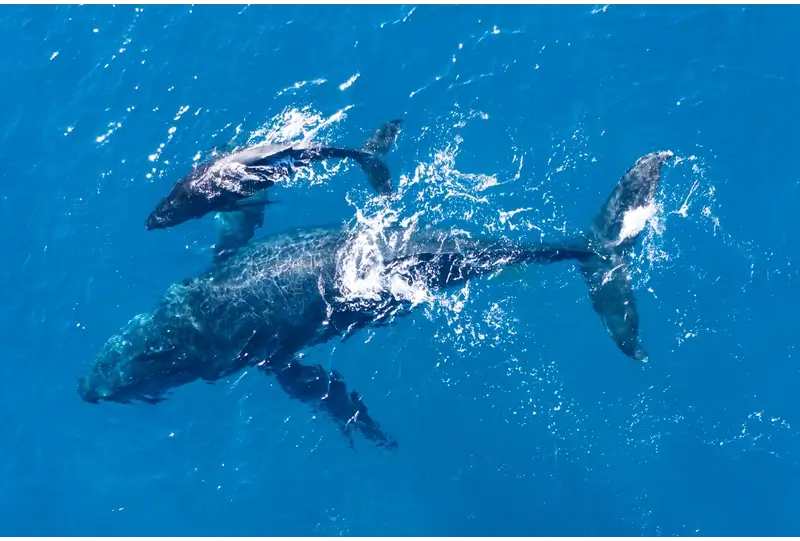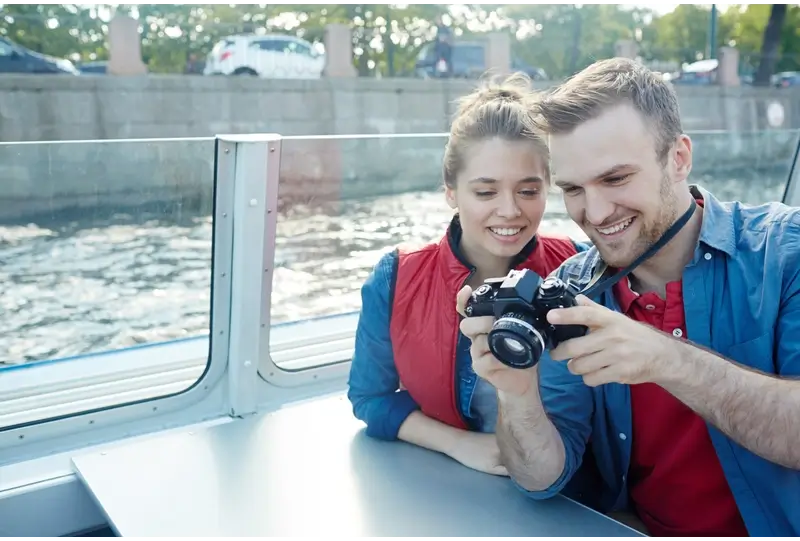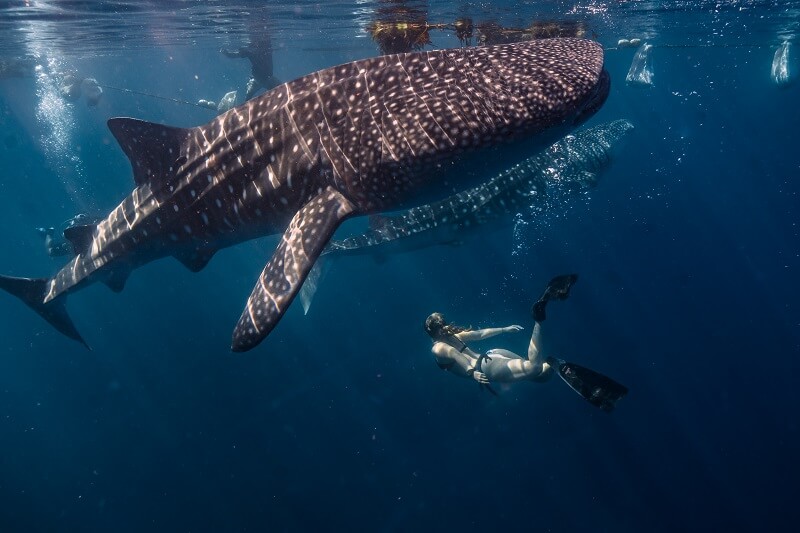Whale watching in Maui is a must-do activity. Every year, these majestic creatures migrate here.
Hey friends, gather around! I’ve got to tell you about the best time for whale watching in Maui. It’s an experience that left me in awe. Picture this: massive humpback whales breaching the ocean surface, their tails slapping the water. Let’s dive into my journey and why Maui is the ultimate spot for this adventure.
Why Maui’s the Place for Whale Watching
I’ve traveled far and wide, but Maui’s whale watching is something else. Every winter, thousands of humpback whales migrate to Maui’s warm waters. They come from Alaska to breed and nurse their calves. The Auau Channel, between Maui, Lanai, and Molokai, is their playground. It’s like nature’s own theater, and I was front row.
The best time for whale watching in Maui is from December to April. February and March are peak months. During these months, the whales are most active. I saw them breaching, tail-slapping, and even singing underwater. Trust me, it’s a show you don’t want to miss.
My First Whale Watching Tour
My first tour was with Pacific Whale Foundation. I booked a morning trip from Lahaina Harbor. The boat wasn’t too crowded, which I loved. Naturalists onboard shared facts about humpback whales. They pointed out every whale behavior, making the experience so rich.
We spotted a pod of whales within minutes. A mother and calf were swimming close by. The calf was playful, splashing around like a kid in a pool. I couldn’t stop snapping photos. The crew’s passion for marine life made it even more special.

Timing It Right: When to Go
Timing is everything for whale watching in Maui. I learned December kicks off the season as whales start arriving. By January, their numbers grow, and sightings are almost guaranteed. February and March are when the action peaks. I saw whales every time I went out during these months.
April is still good, but the whales start heading back to Alaska. Mornings are my favorite time for tours. The water’s calmer, and whales are more active. I tried an afternoon tour once, but the wind made it less pleasant. Stick to early trips for the best experience.
Choosing the Perfect Tour Operator
I tried a few operators, and each had its charm. Pacific Whale Foundation stood out for its eco-focus. Their boats are designed to minimize disturbance to whales. Trilogy Excursions offered a more luxurious vibe with smaller groups. I felt like royalty on their catamaran.
Maui Adventure Cruises was great for a thrilling ride. Their smaller rafts got us closer to the whales. Ultimate Whale Watch & Snorkel had similar high-energy trips. Research operators on their websites, like pacificwhale.org or trilogy.com, to find your fit. Each offers unique experiences, so pick based on your vibe.
What to Expect on a Whale Watching Tour
Let me paint the picture of a typical tour. You board at Lahaina or Ma’alaea Harbor. The crew gives a quick safety talk. Then, you’re off, scanning the horizon for whale spouts. It’s like a treasure hunt, and the excitement builds with every sighting.
Tours usually last two to three hours. Naturalists explain whale behaviors, like breaching or fluking. I heard whale songs through hydrophones on one trip—hauntingly beautiful. Bring binoculars and a camera with a zoom lens. You’ll want to capture every moment.
Whale Behaviors That Blew My Mind
Humpback whales are like ocean acrobats. I saw them breach, leaping out of the water and crashing back down. Tail slaps were another highlight, sending water spraying everywhere. One time, a whale spy-hopped, poking its head out to look at us. It felt like we made eye contact.
Males sing complex songs to attract mates. I listened through a hydrophone, and it was otherworldly. Calves stick close to their moms, learning the ropes. Watching these behaviors felt like peeking into their world. Every tour brought something new and unexpected.
Best Spots for Whale Watching in Maui
The Auau Channel is whale central. I took tours from Lahaina and Ma’alaea, both perfect starting points. Lahaina’s harbor is bustling and full of charm. Ma’alaea’s quieter, with faster access to deep waters. Both gave me incredible sightings.
Shore-based watching is great too. I loved McGregor Point and Papawai Lookout on the road to Lahaina. Binoculars helped spot distant whales. These spots are free and less crowded. Check mauiwhalewatching.com for more lookout points.

Weather and Ocean Conditions
Maui’s winter weather is usually perfect for whale watching. December to April brings mild temperatures and calm seas. I found mornings less windy, making for smoother rides. Trade winds can pick up in the afternoon, so plan accordingly. Always check weather updates on sites like weather.gov before heading out.
Rain is rare, but it happens. I got caught in a light drizzle once, but it didn’t ruin the trip. Boats provide cover, and whales don’t care about a little rain. Dress in layers and bring a light jacket. You’ll stay comfortable no matter the weather.
Tips for an Epic Whale Watching Experience
Let me share some tips from my trips. Book tours in advance, especially in February and March. Popular operators like Pacific Whale Foundation fill up fast. I used their website, pacificwhale.org, for easy booking. Morning tours are less crowded and offer better conditions.
Bring sunscreen and a hat—Maui’s sun is strong even in winter. Motion sickness pills are a lifesaver if you’re prone to seasickness. I took Dramamine before one choppy trip, and it worked wonders. Don’t forget your camera, but also take time to just soak it in. Whales are mesmerizing in person.
Combining Whale Watching with Other Maui Adventures
Whale watching pairs perfectly with other Maui activities. I went snorkeling at Molokini Crater after one tour. The clear waters were unreal, and some operators combine both activities. Check trilogy.com for combo tours. It’s a full day of ocean magic.
I also hiked in Haleakalā National Park. The contrast of volcanic landscapes and ocean views was stunning. Road to Hana is another must-do. I stopped at waterfalls and beaches between whale watching trips. Maui’s diversity makes every day an adventure.
Cultural and Environmental Respect
Whale watching taught me about Maui’s cultural and environmental values. Native Hawaiians revere whales, calling them koholā. I learned this from a naturalist on a Trilogy tour. Operators follow strict guidelines to protect whales. Boats must stay 100 yards away, ensuring minimal disturbance.
I appreciated how operators like Ultimate Whale Watch educated us on conservation. They shared how climate change affects whale migration. It made me more mindful of my environmental impact. Supporting eco-conscious operators feels good and keeps Maui pristine. Visit hawaiioceanproject.com for more on sustainable practices.
Shore-Based Whale Watching
Not every whale watching experience needs a boat. I spent an afternoon at Papawai Lookout, spotting whales with binoculars. It’s on the Honoapiilani Highway, easy to reach. McGregor Point was another favorite, with whales breaching just offshore. These spots are perfect for a low-key day.
Local websites like mauicounty.gov list lookout points. I brought a picnic and made an afternoon of it. You don’t need to spend a dime to see whales from shore. It’s a budget-friendly way to enjoy the spectacle. Just be patient—whales appear when they’re ready.
Family-Friendly Whale Watching
I took my niece on a family-friendly tour, and she was thrilled. Pacific Whale Foundation offers kid-focused trips with educational activities. The crew taught her about whale anatomy and behaviors. She loved using the hydrophone to hear whale songs. It was a hit for all ages.
Many operators provide discounts for kids. Check mauiadventurecruises.com for family packages. Boats have snacks and restrooms, keeping everyone comfortable. It’s a great way to spark a love for nature in kids. My niece still talks about “her” whales.
Photography Tips for Whale Watching
Capturing whales on camera was a highlight for me. I used a DSLR with a 70-200mm zoom lens. It caught distant breaches perfectly. A GoPro worked great for video, especially on raft tours. Tripods are tricky on boats, so I handheld everything.
Timing is key for great shots. I watched for spouts to predict breaches. Overcast days gave softer light, perfect for photos. Check out tips on mauiphoto.com for more photography advice. Practice patience, and you’ll get that dream shot.

Whale Watching and Maui’s Ecosystem
Whale watching opened my eyes to Maui’s marine ecosystem. Humpback whales are keystone species, supporting ocean health. I learned this from a naturalist on a Maui Adventure Cruises tour. They explained how whales’ feeding habits help nutrient cycling. It’s fascinating how everything connects.
Other marine life joins the show too. I saw spinner dolphins and sea turtles on several trips. Operators like hawaiioceanproject.com emphasize protecting the entire ecosystem. It made me appreciate Maui’s waters even more. Every tour felt like a lesson in nature’s balance.
Planning Your Trip: Practical Details
Planning a whale watching trip is easy with some prep. I booked most tours online through operator websites. Pacific Whale Foundation and Trilogy have user-friendly booking systems. Prices range from $50 to $150 per person, depending on the tour. Check pacificwhale.org or trilogy.com for deals.
Tours depart from Lahaina or Ma’alaea Harbor. Parking is limited, so arrive early. I brought a small backpack with essentials: water, sunscreen, and snacks. Most boats have restrooms and shaded areas. Plan for a 2-3 hour adventure, and you’re set.
My Favorite Whale Watching Memory
One moment stands out from all my trips. On a Trilogy catamaran, we saw a competitive pod of male whales. They were chasing a female, breaching and slapping the water. The energy was electric, and the crew was just as excited as we were. It felt like witnessing a wildlife documentary live.
The naturalist explained this was a “heat run,” a rare sight. I got chills watching these giants compete. Moments like that make Maui the best place for whale watching. It’s not just a tour—it’s a front-row seat to nature’s drama. I’ll never forget it.
Comparing Boat Types for Tours
I tried different boats, and each had its perks. Catamarans, like Trilogy’s, were spacious and stable. They’re great for families or those wanting comfort. Rafts, like Maui Adventure Cruises’, felt adventurous and got closer to whales. They’re bumpier but thrilling.
Smaller boats mean fewer people and more personal attention. Larger boats offer amenities like restrooms and snacks. I preferred rafts for excitement but catamarans for relaxation. Check operator sites like ultimatewhalewatch.com for boat details. Pick what suits your vibe.
Whale Watching as a Learning Experience
Every tour taught me something new. Naturalists shared facts about whale migration, biology, and conservation. I learned humpbacks travel 3,000 miles from Alaska to Maui. Their songs can last up to 20 minutes. It’s like attending a marine biology class on the water.
Some operators, like Pacific Whale Foundation, fund research with tour proceeds. I felt good supporting them. Visit their site, pacificwhale.org, to learn about their work. It’s a fun way to learn while enjoying nature. You’ll come away with stories and knowledge.
Budgeting for Your Whale Watching Trip
Whale watching in Maui fits most budgets. Basic tours start at around $50 per person. Luxury options, like Trilogy’s private charters, cost more, up to $150. I found deals on operator websites, especially for early bookings. Group discounts are common too.
Shore-based watching is free at places like Papawai Lookout. I saved money by mixing boat tours with land-based viewing. Check mauicounty.gov for free lookout spots. Food and lodging in Maui can add up, so plan wisely. Whale watching itself is affordable and worth every penny.
Frequently Asked Questions
When is the best time for whale watching in Maui?
The best time is December to April, with February and March being peak months. Whales are most active then, and sightings are nearly guaranteed.
Which tour operator should I choose?
Pacific Whale Foundation is great for eco-conscious tours. Trilogy offers luxury, while Maui Adventure Cruises and Ultimate Whale Watch provide thrilling raft experiences. Check their websites for details.
Do I need to book whale watching tours in advance?
Yes, especially in February and March. Popular tours fill up fast. I booked through operator sites like pacificwhale.org for ease.
Can kids enjoy whale watching in Maui?
Absolutely! Many operators offer family-friendly tours with educational activities. Pacific Whale Foundation has kid-focused programs that my niece loved.
What should I bring on a whale watching tour?
Sunscreen, a hat, binoculars, and a camera are musts. Motion sickness pills help if you’re prone to seasickness. Dress in layers for changing weather.
Takeaway
Whale watching in Maui is a bucket-list adventure. From December to April, humpback whales turn the Auau Channel into a spectacle. My trips with Pacific Whale Foundation, Trilogy, and others were unforgettable. Whether you’re on a boat or shore, the best time for whale watching in Maui delivers magic. Book early, bring a camera, and respect the ocean’s giants. You’ll leave with stories that’ll make your friends jealous. Trust me, Maui’s whales are worth the trip.



